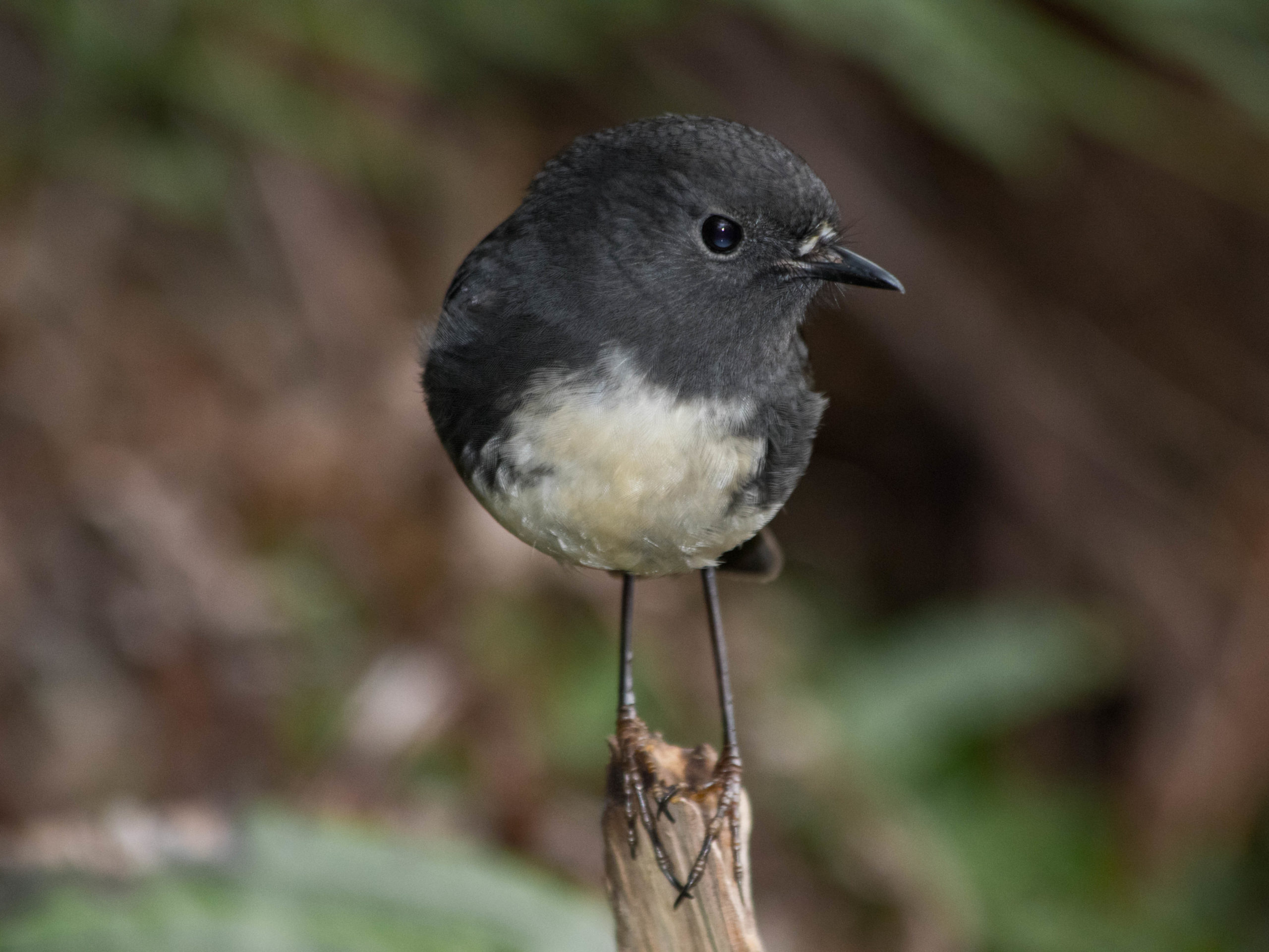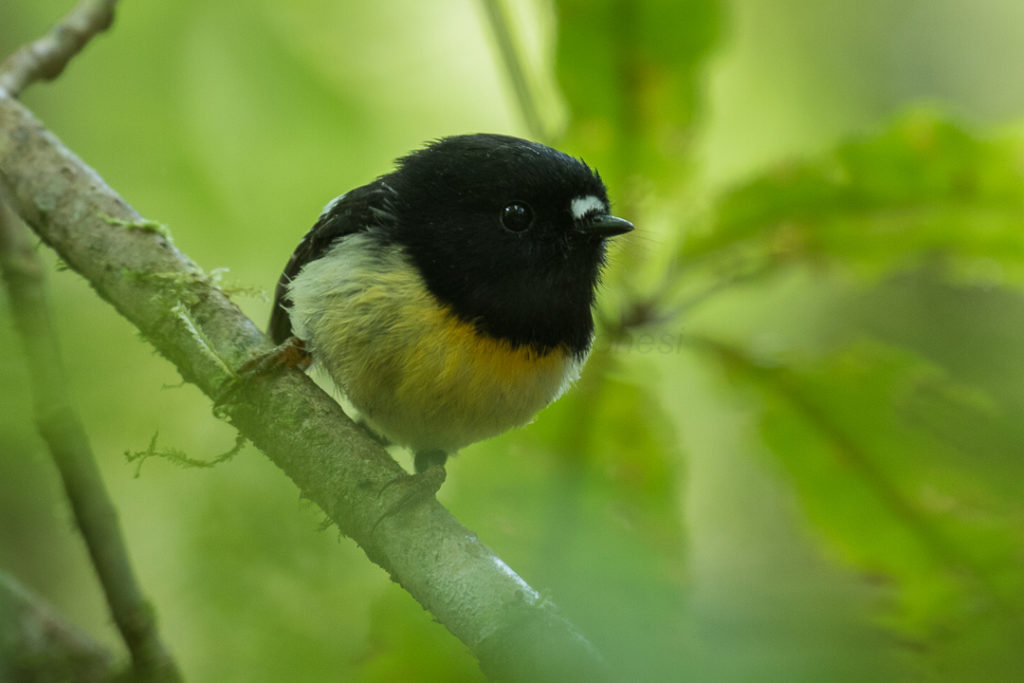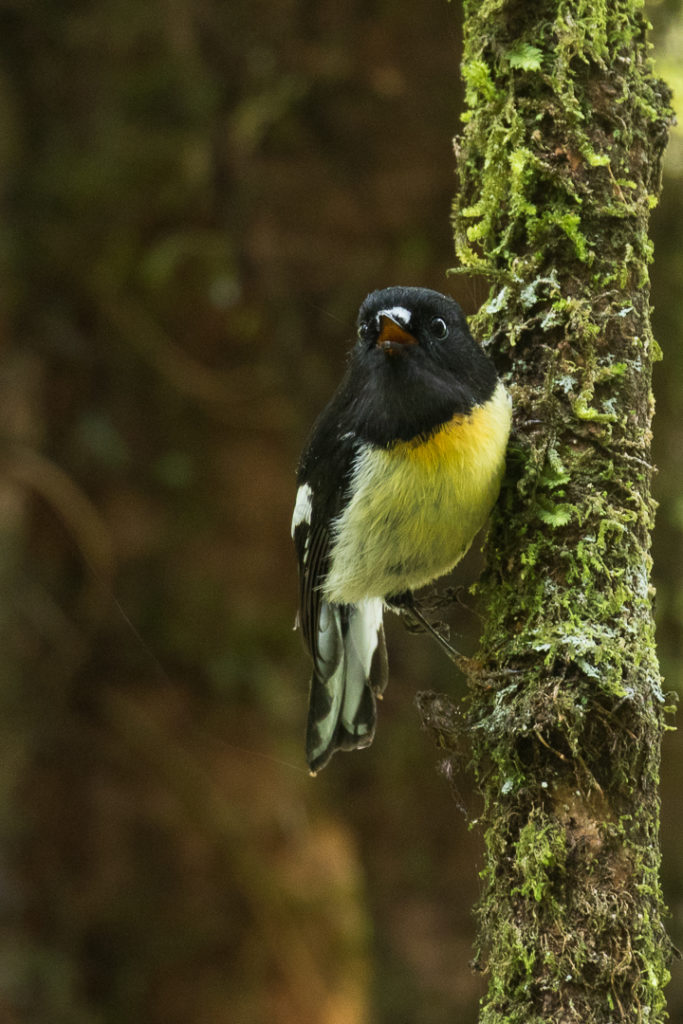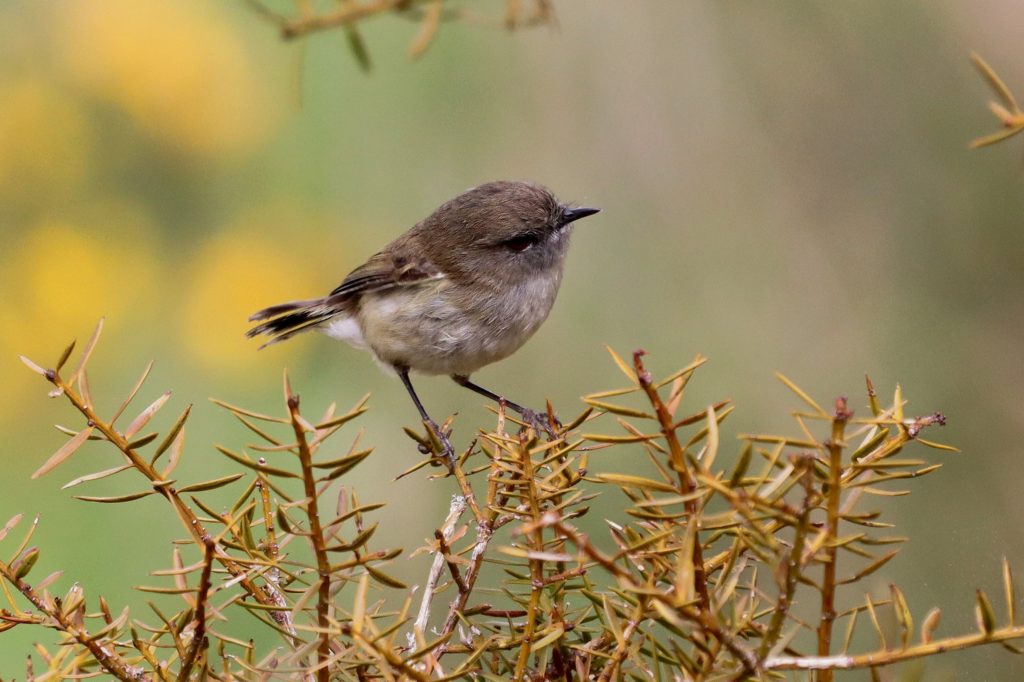Is there such a thing as being too successful? A recent Fiordland study on the recovery of forest birds after longterm predator control and eradication shows that toutouwai/South Island robins, benefitted hugely from the absence of Norway rats and stoats. But the strong recovery of the robins seems to be having a detrimental effect on some of their less bossy fellow bush birds. Competition and aggression between different species have left miromiro/tomtits and riroriro/grey warblers in decline.

The recent study carried out by Colin Miskelly et al builds on work done by the former Department of Scientific Research’s Ecology Division in the 1970s and 1980s and has been recently published in the New Zealand Journal of Ecology.
“Bird surveys undertaken on 47 islands in Breaksea Sound and Dusky Sound, Fiordland, during 1974 to 1986, were repeated on the same islands in 2016 or 2019. During the first block of surveys, Norway rats were present on two islands, and stoat were known or presumed to regularly reach 43 of the remaining islands. The rats were eradicated in 1986 and 1988, and stoats have been controlled to zero density since 2001 on all 28 of the islands surveyed in Dusky Sound, and since 2008 on 12 of 19 islands surveyed in Breaksea Sound.”
So why does predation – and subsequent predator control – affect various bird species differently?
“The greater vulnerability of deep endemic birds (i.e. those endemic at the genus or family level) to predation resulted in forest bird communities at mainland sites being dominated by shallow endemics, recent colonists and introduced species.”
‘Deep endemics’ – our most unique birds – are also our most vulnerable as they have evolved for the longest in the Aotearoa of old. Their numbers are devastated by introduced predators – but the deep endemics are also the species that respond best when those mammal predators are removed.
“Mammalian predator control and eradication programmes throughout New Zealand have revealed that not all bird species respond positively to the removal or reduction of predation pressure, with many bird species declining after mammals are removed or suppressed.”
“Species that benefit from pest mammal eradication are predominantly deep endemics, with many shallow endemics, recent colonists, and introduced species declining. This compensatory response (with some species increasing while others decline) points to interspecific competition having a major role in the structure of forest bird communities once predation pressure is removed.”
The research team investigated the effect of removal of introduced mammalian predators on New Zealand forest bird communities using a unique dataset from 38 small Fiordland islands where either Norway rats or stoats were eradicated, and forest bird communities left to recover with little further management. Responses to management on these islands are compared with forest bird communities on seven nearby islands where ship rats and stoats remain present or able to recolonise readily from the nearby South Island mainland. Possums have never been present on any of the islands in Breaksea and Dusky Sounds.

Boat-based surveys of islands in Breaksea Sound/Te Puaitaha, and around Anchor Island/Pukenui in nearby Dusky Sound/ Tamatea, Fiordland National Park, south-west New Zealand were undertaken over two time periods separated by 30 years.
“During the initial surveys (1974 to 1986), the objective was to undertake inventories of bird, lizard, and pest mammal presence, plus to complete baseline surveys on two islands during preparations for eradicating Norway rats. Most of the bird data available from 1974 to 1986 is presence/absence data or birds per hour encounter rates contained in seven unpublished reports.”
“The second series of surveys (2016 and 2019) was primarily focused on locating and estimating the size of colonies of burrow-nesting petrels. However, all other bird species identified during the surveys were recorded, and the number of individuals detected was estimated.”
“Data was gathered from 71 islands, of which 47 were surveyed during both time periods, 7 were surveyed during 1974–1986 only, and 17 were surveyed during 2016– 2019 only. The earlier island surveys were undertaken at dates spread throughout the year, while 2016–2019 surveys were all undertaken in November or December.”
The researchers evaluated the effects of predator eradication for each species, looking at the number of islands that changed from bird species absence to presence, compared to the number of islands that changed from bird species presence to absence.
“Norway rats were abundant throughout southern Fiordland in the 1880s but disappeared from most sites (including Resolution Island/Mauikatau and Anchor Island/ Pukenui) following colonisation by stoats from 1900. Stoats are very effective predators of Norway rats, and the fact that Norway rats persisted on Breaksea Island (170 ha) and Hāwea Island (9 ha), when they disappeared from all other nearby islands, indicates that stoats never reached these two outermost islands and the adjacent rat-free Wairaki Island.”
Ship rats spread in the South Island at the same time as the spread of stoats, but ship rats failed to establish on most islands included in this study, apart from the Harbour Islands and John Islands in inner Breaksea Sound, where they remain.
“It is unclear whether ship rats out-competed Norway rats in the South Island forests, or whether the smaller, more arboreal ship rats were filling a niche vacated when Norway rats were extirpated by stoats. Norway rats were eradicated from Hāwea Island in 1986, and from Breaksea Island in 1988. Stoats were eradicated from Anchor Island and surrounding islands in 2001 and have been controlled to low density by trapping on Resolution Island since 2008.”

In addition, as stoat traps are maintained on most of the islands off the north coast of Resolution Island (from Breaksea Island to Entry Island), all these islands have effectively been free of introduced mammal predators since 2008.
“The effectiveness of this trap network is evident from the dispersal and establishment of South Island robins reported herein. However, traps are not maintained on the Harbour Islands and John Islands, east of the northern entrance to Acheron Passage, all seven of which were surveyed during both time periods. Stoats, along with ship rats, remain present on (or regularly visit) the Harbour Islands and John Islands.”
According to the researchers, there are currently 4971 ‘DOC 150’ stoat traps set in Breaksea and Dusky Sounds (3571 on Resolution Island), which are checked three times per year.
Few of the islands included in this study have had translocated birds released on them in the last 100 years.
“The one clear exception is Breaksea Island, where South Island saddleback were released in 1993, and mohua/yellowhead in 1995. South Island robins (= robin) were translocated from Breaksea Island to Hāwea Island in 1987; however, birds have been recorded flying in both directions between the two islands, and the 560 m water gap is well within their flying ability, suggesting that robins would have colonised Hāwea Island naturally within a few years of rat eradication. Robins were translocated from Breaksea Island to nearby Entry Island in 1989, but the translocation failed in the absence of stoat control. The robins now present on Entry Island have colonised naturally since stoat control was initiated there in 2008.”
Anchor Island (1137 ha) was not included in this study, but saddlebacks, mohua, and robins were all released there between 2002–2004.
“These three species have subsequently colonised a few islands (saddleback and mohua) or most islands (robin) surrounding Anchor Island, plus robins have colonised most of the islands off the north coast of Resolution Island. Mohua have also been released on Pigeon Island (3.7 km north of Anchor Island), and robins on both Pigeon Island and Indian Island (the latter is 2.7 km south-east of Anchor Island).”

Some forest bird species have limited flying ability or willingness to cross water, meaning these species couldn’t take full advantage of their neighbourhood’s predator-free status.
So which species expanded in distribution after predator eradication and which declined?
“Few forest bird species responded positively at a landscape scale to eradication of predatory mammals on Fiordland islands. South Island saddleback and mohua could only be reintroduced after rats or stoats were eradicated, but their limited dispersal ability meant that we encountered them on only four (saddleback) and three (mohua) islands other than release sites. Colonisation of these additional islands required water crossings of no more than 100 m (saddleback) and 65 m (mohua) from the release sites, leaving much suitable habitat inaccessible to them.”
But other species took full advantage of their predator-free opportunies.
“Two stronger-flying species with the potential to reach all study islands showed a significant response to pest mammal eradication. Robins were confined to Breaksea Island during 1974–1986 and increased dramatically there after rat eradication. During the 2016–2019 surveys, robins were found on an additional 47 islands where they had previously been absent, including 30 that had been visited during 1974–1986. In addition to being widely distributed, robins were the most frequently encountered birds during the second block of surveys. However, robins had not colonised the unmanaged Harbour Islands and John Islands, despite them being within robin flight range from Entry Island via the adjacent South Island mainland.”
Kākā were the other conspicuous success.
“Kākā were present on several of the islands in Breaksea Sound throughout the study; however, they were not recorded on or around Anchor Island during 1974–1986. They are now abundant on Anchor Island, and we recorded them on 15 nearby islands.”
Some species were apparently unaffected by pest mammal eradications.
“The endemic bellbird and the introduced blackbird were both widespread before and after pest mammal eradications. There was no apparent change in bellbird or blackbird encounter rates following pest mammal suppression.”
And then there were the species that actually had reduced distributions after mammal predators were removed.
“Six species were encountered on significantly fewer islands after pest mammal eradications. Kererū were observed on few islands in 2016 and 2019, and two of these (islets north-east of Anchor Island) were sites that were not surveyed during 1974–1986 and so were excluded from analysis. Kererū regularly fly tens of kilometres in search of seasonal food sources. Further surveys at other times of the year are required to determine whether kererū distribution in coastal Fiordland has been influenced by stoat and rat eradication.”
“The five remaining species that were recorded on significantly fewer islands in 2016 and 2019 were all small passerines: the shallow endemics tomtit and grey warbler, the recent coloniser silvereye and the introduced dunnock and chaffinch. Following stoat eradication, tomtits disappeared from all the small islands around Anchor Island. Norway rat eradication also apparently led to local extinction of tomtits on Breaksea and Hāwea Islands; however, they were still present on several islands in Breaksea Sound, including the unmanaged Harbour and John Islands.”
“Silvereyes were encountered on fewer islands than tomtits during 1974–1986, and all but disappeared from managed islands following stoat and rat eradication. They remain present on the unmanaged Harbour and John Islands.”
Dunnocks and chaffinches – both introduced species – appear to cope better in the presence of introduced predators than without.
“Dunnocks were detected on 16 islands during 1974–1986; however, they were not recorded on the Harbour and John Islands. Dunnocks were not detected at any site following the eradication of stoats and rats. Chaffinches disappeared from all but one managed site; however, they were recorded on four of the five (unmanaged) John Islands in 2019.”
There were no significant changes in bird communities on the Harbour and John Islands (combined) in Breaksea Sound between 1974–1986 and 2019. These seven islands have received no predator mammal control.
So why did robins and kākā do so much better than other species? As cavity nesters, they are particularly vulnerable to mammal predators.

“The two species that benefitted most from pest mammal eradications on Fiordland islands (robin and kākā) are large or medium-sized endemic species that typically nest in tree-holes or cavities. These characters fit the pattern for species that benefitted from pest mammal control based on a meta-analysis of 24 New Zealand restoration projects.”
Other bird species seemed unable to take full advantage of their new situation.
“South Island saddleback and mohua were successfully translocated to several Fiordland islands following pest mammal eradications. However, their limited dispersal ability has meant that they have been unable to disperse to many of the islands that we surveyed. Poor dispersal ability may also have contributed to rifleman and brown creeper/ pīpipi (both of which are also deep endemics) failing to respond to pest mammal eradications on islands in Breaksea and Dusky Sounds.”
So what does this mean for conservation and restoration projects generally?
“Deep endemic birds exhibit a suite of behaviours and life history traits that make them especially vulnerable to mammalian predators (including reduced flying ability, naïvety to predators, delayed maturity, and low fecundity), and it is assumed that these traits evolved in response to reduced predation pressure compared to their nearest relatives (typically in continental Australia) that co-evolved with numerous predatory mammals and reptiles.”
It’s no surprise then, that these species respond well to predator control. But why don’t other bird species also benefit?
“While it is intuitively apparent that these deep endemic birds would respond positively to the removal of predation pressure, it is counterintuitive that other more fecund bird species (including shallow endemics, recent colonists, and introduced species) do not increase when predatory mammals are eradicated.”
“A striking finding of the Fiordland island surveys was the large number of bird species that were encountered less often following eradication of Norway rats and stoats, most notably a suite of small-bodied insectivores (tomtit, silvereye, dunnock, chaffinch, and grey warbler). With the exception of tomtit (which is present at few restoration sites) these species were among the six species that had negative or neutral responses to pest mammal control throughout New Zealand.”
The two most comprehensive and well-documented bird restoration sites in New Zealand are Tiritiri Mātangi Island in the Hauraki Gulf, and the fenced Zealandia/Karori Sanctuary in Wellington, with eleven and nine successful bird translocations respectively by 2012.Those two restoration sites and the Fiordland study area have very different conservation histories. Yet despite those differences, say the researchers, the bird community responses to predator suppression, and the subsequent reintroduction or colonisation of additional deep endemic bird species, at all three sites have been remarkably similar.
“With the exception of tūī (which increased markedly), few of the resident Zealandia birds showed any significant response to pest mammal eradication per se. This suggests that the other species that had survived at the site in the presence of ship rats, stoats, and possums were not limited by mammal predation. However, nine species (including silvereye, fantail, grey warbler, chaffinch, and dunnock) declined once several deep endemic bird species were successfully re-established at the site and tūī had increased further. In addition to the resident species that declined following the re-establishment of a deep-endemic bird community, an attempted translocation of tomtits failed, apparently due to increasing aggression from an expanding North Island robin population.”
“The most likely explanation for insectivorous bird species declining following the eradication of predators is that they have been out-competed by those (deep endemic) bird species that responded positively to predator release.”
The declines in small insectivorous birds on Tiritiri Mātangi and at Zealandia could be attributed to either one or a few strong competitors given the number of deep endemic species that are now abundant at these sites. The situation is clearer on Fiordland islands, however, as only two species responded positively to predator suppression. The South Island robin is the only predominantly insectivorous species of the two and was encountered on nearly twice as many islands as kākā.
“South Island robin was suggested as the reason why tomtits had disappeared from many islands in Dusky Sound. The more comprehensive dataset presented herein points to the spread of South Island robin to nearly all islands in Breaksea and Dusky Sounds as being the likely explanation for the decline and disappearance of a guild of small insectivorous passerines. We suggest that the closely related North Island robin played a similar role at Zealandia, and possibly on Tiritiri Mātangi.”
Different species can compete for the same food (exploitative competition) or a more aggressive species can compete through interference competition.
“Both mechanisms have been proposed for interactions between endemic New Zealand bird species, with North Island robins observed harassing tomtits that were carrying food to nestlings (interference competition), and bellbirds able to access flowers inside small divaricating shrubs and from less robust perches than the much larger tūī (exploitative competition).”
Only some of the species in decline in the study are likely to have been affected by competition with robins for food as robins feed mainly on the ground.
“It is therefore expected that robins could compete directly for food with other species that spend much time foraging on the ground, including tomtit, dunnock, and chaffinch. It is less likely that robins would compete for food with bird species that feed almost entirely in the canopy (e.g. grey warbler and silvereye), especially given that their prey is predominantly invertebrate species that spend their entire lifecycle among canopy foliage.”
Are our friendly, curious toutouwai actually bush bullies?
“New Zealand robins are frequently observed being aggressive to each other. Agonistic displays are also directed at other species (including tomtit, fantail, and silvereye), and South Island robins were reported chasing and attacking other species that entered their territories or came close to nests, as well as aggressively defending food caches against other species. This points to direct aggression by robins being the most likely reason why smaller bird species decline on (or are excluded from) small islands when robins become abundant.”
All of which gives researchers, restoration managers and conservationists something new to factor in and think about.
“The role of interspecific competition in structuring bird communities is widely accepted in continental ecosystems, yet has received little attention from New Zealand ecologists, who have focused on the role of predation. When competition has been raised as a potential limiting factor for endemic New Zealand birds, this was mainly in relation to competition from introduced mammals and vespulid wasps, rather than other bird species.”
The good news is that introduced birds don’t seem to be any sort of serious competition for our own endemic species.
“It has long been recognised that introduced bird species are a minor component of bird communities at New Zealand sites with intact forest and few or no introduced mammals present. The observed declines of introduced bird species as deep endemic bird communities recovered at restoration sites (including Tiritiri Mātangi, Zealandia, and Fiordland islands), point to most introduced bird species as being competitively inferior to deep endemic New Zealand birds in the absence of mammalian predators. This is a complete reversal of the perceptions of early New Zealand ecologists, who considered introduced European birds to be competitively superior to endemic species.”
But when it comes to robins or tomtits, restoration managers may need to make a choice.
“Our work has implications for managers of ecological restoration sites throughout New Zealand. While eradication or suppression of introduced predators is likely to result in increased densities of deep endemic bird species (or opportunities for their re-introduction), restoration of robins (in particular) may result in the decline, disappearance or exclusion of other native bird species, including some endemic species.”
The full research report is freely available online in the New Zealand Journal of Ecology

